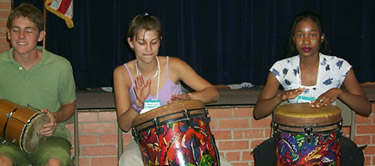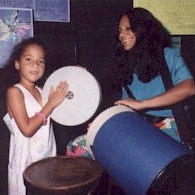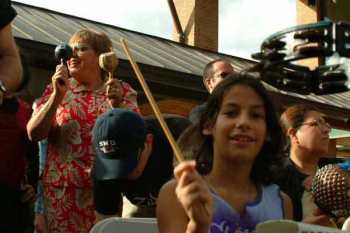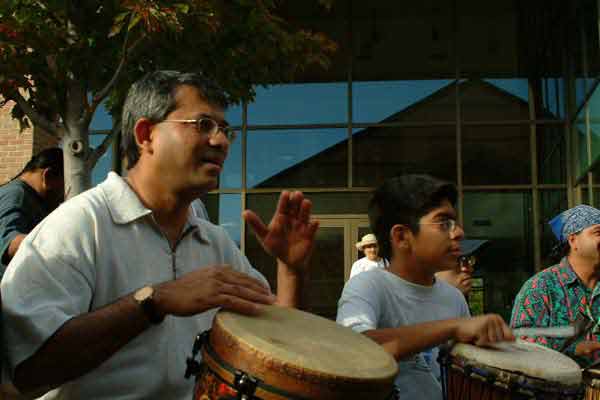| |
FACT: This type of 'tribal' style informal drum circle has its historical roots in the U.S. cultural revolution of the nineteen sixties. Many community circles here today still have a counter-culture style or flavor to them. Apparently the drumming, at least, was a good idea, because it is now being heartily embraced by mainstream societies around the world. SIDE TRIP: Watch a video about one of the older, better established community circles in the U.S.A.: the Griffith Park circle in Los Angeles. Other drum circles with a long term history are Hippie Hill in San Fransisco, which has been going strong for over 40 years, and the long famous Harlem drumming scene, at Marcus Garvey Park, which has recently been attacked by the incoming yuppies who, by complaining, are ruining a Harlem recreational drumming scene which has been a tradition for decades. another very well developed community drum circle is the Venice Beach Circle, in Southern California. |
Did Arthur Hull invent the Drum Circle?
No, he did not. He played in earlier community drum circles around the San Fransisco Bay area before he began doing his programs, and was nurtured in a musical environment which included freeform circles like those of the Rainbow Tribe and Hippie Hill. Arthur HAS, however, inspired and popularized the use of the FACILITATED drum circle, which is a very powerful tool for change, and he has empowered many bright people, from many walks of life, with knowledge of the principles of facilitating a music making event in circle format. The overall effect of his activity on the growing recreational drumming and music making scene is unmistakable and profound. Arthur has brought the joy of drumming to a great many people who were not exposed to it previously.
Virtually everyone working with facilitated drum circles today has been affected by his work. Thanks, Arthur.
For more on stu's take on Arthur Hull, and facilitated drum circles, see this page.
 How
is a Community drum circle different from regular African or other traditional
drumming situations?
How
is a Community drum circle different from regular African or other traditional
drumming situations?
Many cultures have long and distinct musical traditions, and the goal is not only the making of good music, but the preservation/transmission of the culture in a relatively traditional form. There is a way to do the music, and a way not to do it. Only experienced and authorized drummers are supposed to play, and there is a prescribed method of getting to that position, usually study with one of the master drummers. This too is a rewarding musical experience, but it's different from a community drum circle. Examples of this would be African drum & dance classes, a Cuban style rumba, or perhaps a belly dancing event, with doumbek and sometimes riq accompaniment..
 A
community drum circle, in contrast, is often a fun, multicultural,
mixed level, group music making event, with freely improvised rhythms,
and the music is created on the spot, in the moment. There is no 'audience';
everyone is welcome to play, dance, or listen as the mood strikes them.
Bring a drum if you have one. It's a jam session, an exploration. The
language of rhythm transcends normal communication boundaries, so one
sometimes finds folks interacting who would normally have trouble doing
so..
A
community drum circle, in contrast, is often a fun, multicultural,
mixed level, group music making event, with freely improvised rhythms,
and the music is created on the spot, in the moment. There is no 'audience';
everyone is welcome to play, dance, or listen as the mood strikes them.
Bring a drum if you have one. It's a jam session, an exploration. The
language of rhythm transcends normal communication boundaries, so one
sometimes finds folks interacting who would normally have trouble doing
so..
Often at larger community drum circles, some people will choose to dance in the middle of the circle, or fire/hoop dancers or others will be practicing at the same time, so that the drumming is part of a larger social event.
Facilitated drum circles may have a specific focus, like an educational kids' circle, a team building session for corporate executives, or a therapy session for special needs populations and done or accompanied by a music therapist.
Facilitated drum circles are more highly organized, accompanied by a protocol which sometimes involves other steps as well, in addition to drumming, such as guided imagery, discussion, and so on. Rather than a teacher, the leader is referred to as a facilitator, and it is his job to make the music making process as easy as possible for all..
The demographics of the group, and the intention of the gathering, along with the instrumentation, the room/setting logistics, and the background & skill of the facilitator or facilitation team, if there is one, determine the direction the circle will take.
I sometimes attend a weekly community drum circle. Why is the music so much fun one time, and so frustrating another time?
Community drum circles tend vary widely in quality, depending on the facilitator, participant demographics, the beginner to advanced ratio, and the general state of mind of the players. It can be very subjective. More than once, I have finished playing, feeling (one way or another), to discover that the guy next to me had been feeling just the opposite. Music is a many faceted and wonderful thing.
 Sometimes
the source of irritation is obvious, like a loud aggressive drummer
who is not listening to the rest of the group, drowning everyone else
out. there are various interventions which might be tried, to reach
the guy, but the best thing for you, the newbie, to do at that point
is to move around the circle to see if there is a place where the sound
isn't too overbearing. It changes every few feet, in bigger rooms or
outdoors. You might try earplugs, and/or switching from an overworked
hand drum to bell or shakers. It is supposed to be fun, and relaxing.
If you are frustrated or in pain, this isn't how it should be.
Sometimes
the source of irritation is obvious, like a loud aggressive drummer
who is not listening to the rest of the group, drowning everyone else
out. there are various interventions which might be tried, to reach
the guy, but the best thing for you, the newbie, to do at that point
is to move around the circle to see if there is a place where the sound
isn't too overbearing. It changes every few feet, in bigger rooms or
outdoors. You might try earplugs, and/or switching from an overworked
hand drum to bell or shakers. It is supposed to be fun, and relaxing.
If you are frustrated or in pain, this isn't how it should be.
Are there universal principles that apply to the physical act of drumming?
Yes. Posturally, you should try to keep your head, heart, and hips in a straight vertical line. Keep your shoulders relaxed, and breathe calmly. if you experience pain, STOP doing whatever is causing the pain. It isn't supposed to hurt. When you catch your shoulders tensing up, simply relax them, let them down. Consciously tell your muscles to relax.
The qualities of relaxation and simple awareness [attention]greatly enhance the experience. Drums respond to changes in where the instrument is struck, rubbed or shaken, how hard, with what shape (which part of your hand or a stick or mallet touches which part of the instrument, in what way). in the case of a shaker, the position of the shaker and the direction speed and size of the movement all produce different results. It is fascinating to manipulate these parameters for musical effect. Keep eye contact with the other players, and use all the audio AND visual information to find a part that fits and supports..
The leader at a local drum circle near me keeps asking me to play the same simple thing over and over. Why won't he let me play what I want?
Without seeing you and your facilitator in action, I couldn't really say for sure. In a good community drum circle, there has to be a balance between spontaneity and order.
He may recognize in you the ability to do something which he thinks will help stabilize the rhythm. (Then again, he could be treating the drum circle like a drum class, trying to 'push the river', instead of letting it flow by itself.) This depends on the musical factors at work in YOUR circle. It's a flux, a continuum. Give him a chance. Play your part modestly for awhile to help the groove get going, and play very simply, and instead of doodling, use the extra consciousness to listen to everyone else. Maintain eye contact. Leave lots of open spaces. Listen more than you speak. Don't play too loud. Notice how the main parts all interact. THEN, if you feel a certain part, go with it. If he objects again at that point, maybe he is the one who needs to adapt.
What's the best instrument to start out on?
What is YOUR situation? If you buy a big loud
drum, but you live in a small apartment, uh...you'll want to have a
place to go and play.
Start experimenting , and resolve to explore rhythm. Your body is a great first instrument. Play it, until you get a drum. The human body was the very first instrument.
Musical side trip: Body Percussion or Body Music
Explore Keith Terry's Concept of Rhythm Blocks
Watch Barbatuques
Watch Papo Gonzalez
If you are like most of us, you will eventually amass a collection of drums, shakers, bells, scrapers, and so on.. You can easily start with some smaller percussion instruments, perhaps a tamborine, a bell of some sort, and a few shakers, and expand your collection from there as your situation evolves. There are also lots of homemade and found options; see our homemade page for more on this.
coming soon:
How do I find a good teacher?
How hard is it to start your own drum circle?
Are there any good books and videos to help me along?

 What
the heck is a drum circle? - A drum circle, most simply put,
is a group of people gathered into a circle for the purpose of making
music with percussion instruments. It can be as simple as three friends
in a living room, or as involved as a thousand music industry workers
jamming outside the Civic Center in Anaheim after the NAMM show closes.
What
the heck is a drum circle? - A drum circle, most simply put,
is a group of people gathered into a circle for the purpose of making
music with percussion instruments. It can be as simple as three friends
in a living room, or as involved as a thousand music industry workers
jamming outside the Civic Center in Anaheim after the NAMM show closes.